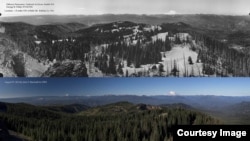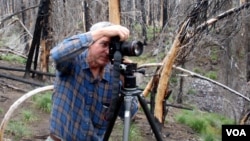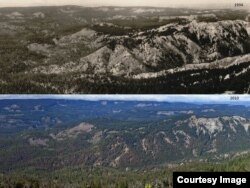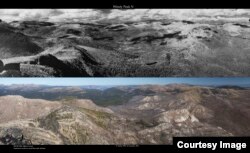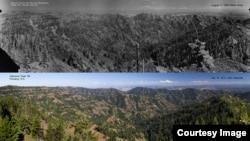During the 1930's, U.S. Forest Service crews visited more than 800 fire lookout stations across the Pacific Northwest to capture sweeping black-and-white photographs of the landscape. The resulting collection is called the Osborne Panoramas. Today, 80 years later, the historic images are helping forestry officials refine their fire management practices.
Research ecologist Paul Hessburg says a picture - especially a panoramic one - is worth a thousand words.
"We can tell an amazing story with these pictures. We can go back, find those photo points, take new pictures of them and compare the old '30's view with the current view and tell in pictures about the tremendous change in the forests and why they are burning and functioning the way they are today."
And that's what the Forest Service did. For the repeat photography, Hessburg hired professional photographer John Marshall, in what has become a years-long project for the team.
The fact that most of the original lookout towers no longer exist was just one of many challenges Marshall faced. "One week I couldn't get to a site because there was too much snow to drive in on the road," he recalled. "A week later, a forest fire had started somewhere else and was blowing smoke over it. We had nothing but smoke for two months."
So far, Marshall has re-photographed 92 Osborne panoramas. He says different places tell different stories.
For example, the 1930's view of low to middle elevation forests in north-central Washington's Okanogan-Wenatchee National Forest shows a relatively open, park-like landscape. But in his photo, Marshall said, the trees are more densely packed. "You see the meadows shrinking up, the spaces between groves of trees filling in. It's more trees, less open area."
In historic times, these woods would experience regular low-intensity burns. Those would clean out the undergrowth of shrubs and saplings, leaving the big, thick-barked old trees standing. Now, as the ironic result of effective firefighting, the forests are primed for severe wildfires.
The photographer says that's already evident in the then-and-now view from some higher, alpine lookouts. "You get up into the high country Pasayten Wilderness, what you see in the 1930's photos is a lot of small areas that were burned. What you see now, is enormous areas that were burned."
Massive burns through mature forests are taking the place of the former norm: small burns in a patchwork landscape. Last century, an alpine wildfire would have had a harder time building up a head of steam.
The pictures from the Umatilla National Forest, a half million hectares of mostly v-shaped valleys separated by narrow ridges or plateaus, tell yet another story.
"There are actually some spots barren now that were forested in 1934," Marshall said. "I think that may reflect climate change. It's gotten drier. There have been insect attacks. There's been fire. On the harsher sites - the south aspects in places - the trees aren't coming back."
It turns out Marshall and Hessburg are not the first to mine the trove of Osborne panoramas. In the last decade, the National Park Service commissioned retakes from lookouts in Glacier and Yellowstone parks. Commercial photographers have taken a stab at it here and there too. A number of amateur photographers have undertaken their own time-series projects. In one case, the repeat photography aims to document the recovery of a forest after a wildfire.




